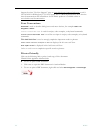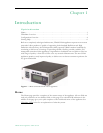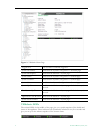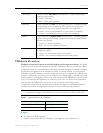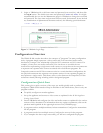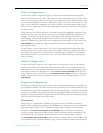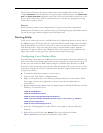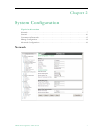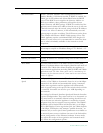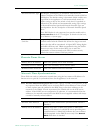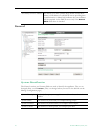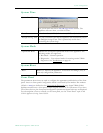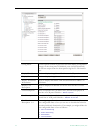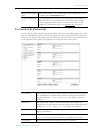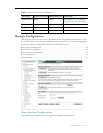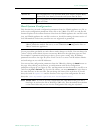
8 © 2009 VBrick Systems, Inc.
Network DHCP Default - Enabled. Dynamic Host Configuration Protocol –
(Enable, Disable). On Ethernet models, if DHCP is enabled, the
VBrick gets its IP Address and Subnet Mask from the DHCP
server. If the DHCP server supplies the Gateway Address or
DNS server address, these parameters will replace the user
entered Gateway and DNS settings. If DHCP is enabled and the
appliance cannot obtain an IP address from the server, it will start
in limited run mode after 90 seconds, using its default IP Address
of
172.17.5.5. After 15 minutes, it will automatically reset and
again attempt to acquire an address. The LCD screen on the front
of the VBrick will indicate a DHCP failed message. Note: The
VBrick appliance requires a minimum DHCP lease length of 8
minutes to work, however it is recommended to extend the lease
time to what is maximally available via the network to avoid
disruptions.
DHCP Retry Interval See above. Use to adjust the time before the appliance will reset
and attempt to acquire an IP address. Range 3–15. Default = 15.
IP address IP Address of the VBrick.
Subnet Mask Subnet mask for the VBrick address.
Gateway IP Address Gateway IP Address for communicating across distinct network
segments.
Host Name The Host Name defaults to the Media Access Control (MAC)
address, a hardware address that uniquely identifies each node of
a network. The VBrick Host Name identifies the appliance to
various network applications including DHCP, SNMP and VBrick
application tools. The Host Name syntax can be a maximum of 18
characters, the first character must be a letter and the rest can be letters,
numbers or hyphens.
Network Interface
Speed
10Mbps, 100Mbps, or Automatic. This allows the Ethernet
interface of the VBrick to be manually forced to 10 or 100 Mbps.
Automatic is the default and recommended setting. Automatic
enables auto negotiation and the appliance will automatically
match its speed setting to the speed of the switch or hub to which
it is attached. Automatic can resolve up to 1GB depending on
your network.
The settings for Network Interface Speed and Network Interface
Type are interdependent. They must both be set to Automatic or
they must both be set manually. Manual settings should be used
only in the rare case when the appliance is attached to network
equipment that does not support auto negotiation. The VBrick's
capabilities will be limited when its Ethernet link is at 10 Mbps
and/or Half Duplex. If auto negotiation fails, the VBrick defaults
to 100 Mbps, Full Duplex, and attempts "parallel detection," an
alternative way to sense speed. Status parameters are available on
the network status screen to indicate the state of the link and the
current configuration of the Ethernet hardware. In auto mode,
they reflect the results of the negotiation and in manual mode
they follow the configuration options.



